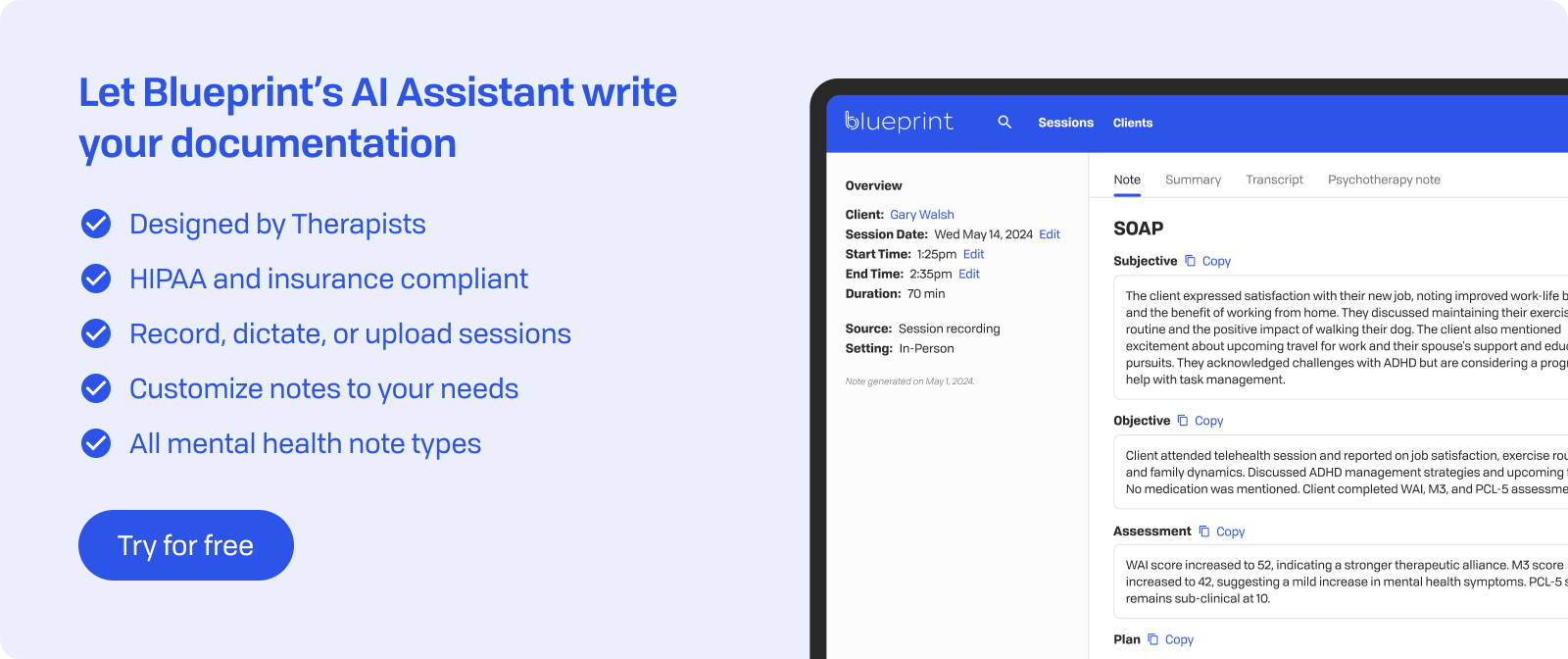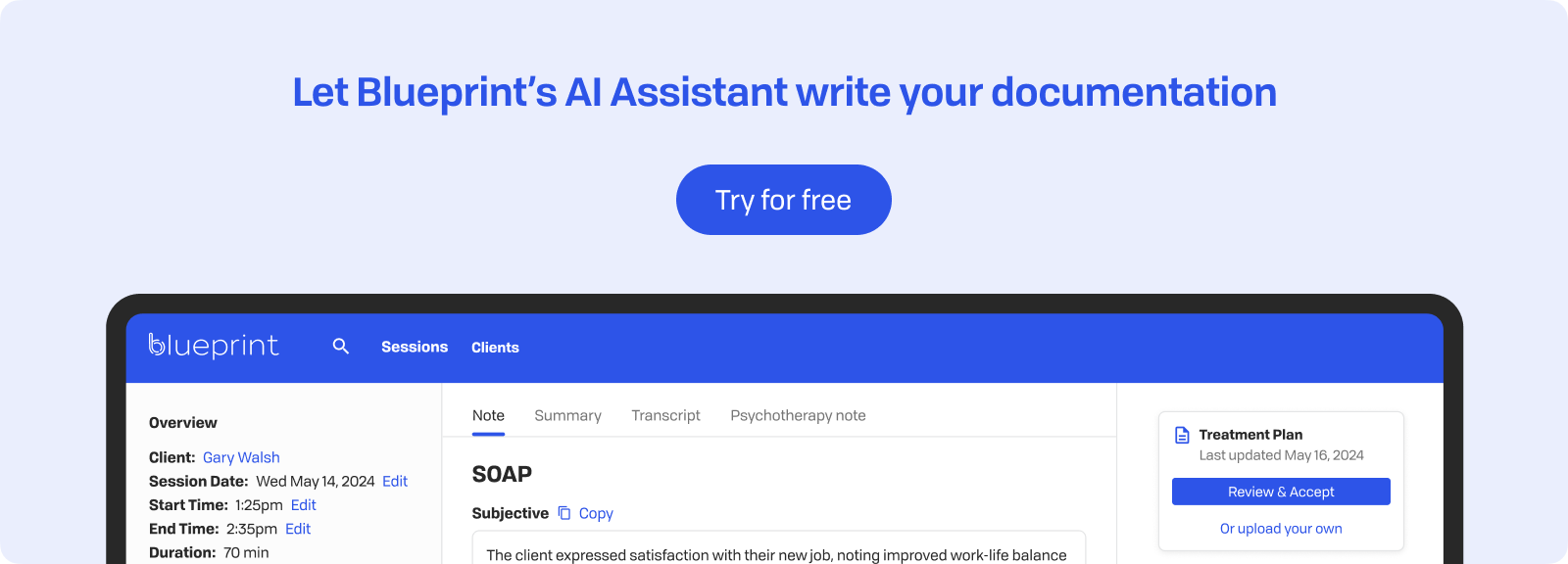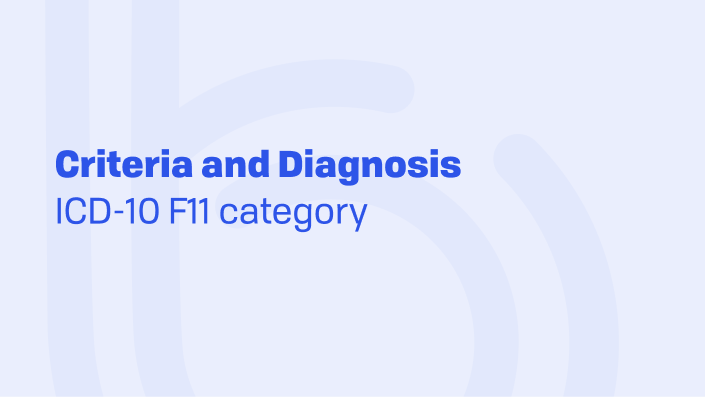In Brief
The opioid crisis has reshaped mental health practice across all clinical settings. Whether you work in private practice, community mental health, or integrated care, you likely encounter clients affected by opioid use. Knowing the details of opioid dependence and its proper clinical coding is now vital for therapists.
Accurate ICD-10-CM coding for opioid-related disorders goes beyond administrative compliance. It directly affects treatment planning, insurance authorization, and clinical communication. The complexity of opioid dependence demands precise documentation that captures both the medical and psychological aspects of the condition. Correct coding ensures your clients receive appropriate care and maintains the clinical integrity of your practice.
Let's look at what opioid dependence means in clinical terms and how to navigate the ICD-10-CM coding system effectively. This understanding helps you provide better care while ensuring your documentation meets both clinical and administrative standards.
Opioid Dependence in Clinical Context
Opioid dependence is a complex condition involving physiological adaptation and psychological reliance on opioid substances. Clinical features include tolerance (needing more for the same effect), withdrawal symptoms when stopping use, and continued use despite harmful consequences. Clients often show compulsive drug-seeking behavior, loss of control over use, and significant impairment in daily functioning.
The prevalence of opioid use disorder (OUD) significantly impacts mental health practices nationwide. Recent data from the 2023 National Survey on Drug Use and Health (NSDUH) indicates that approximately 8.9 million Americans aged 12 or older misused opioids in the past year. Many of these individuals seek therapy for co-occurring mental health conditions like depression, anxiety, or trauma. This scenario means therapists across all specialties need competence in recognizing and addressing opioid-related issues, even when substance use isn't the primary concern, given the high rates of comorbidity and the need for integrated care.
Accurate diagnosis and treatment planning require understanding the distinction between opioid use, abuse, and dependence. Opioid use refers to any consumption of opioid substances, including legitimate medical use. Opioid abuse involves a pattern of use that causes significant impairment or distress but doesn't meet full dependence criteria. Opioid dependence, however, involves both physical adaptation (tolerance and withdrawal) and behavioral patterns that indicate loss of control over use.

Overview of ICD-10-CM Coding for Opioid-Related Disorders
The ICD-10-CM coding system forms the basis for clinical documentation and billing in modern healthcare. This extensive classification system provides standardized codes that capture the complexity of medical conditions, including substance-related disorders. For mental health professionals, understanding ICD-10-CM coding ensures clear communication across healthcare teams and supports continuity of care.
Accurate coding directly affects several key aspects of your practice:
- Treatment Authorization: Insurance companies use specific ICD-10-CM codes to approve treatment plans and determine coverage levels.
- Reimbursement Accuracy: Precise coding reduces claim denials and ensures appropriate payment for services provided.
- Clinical Documentation: Detailed codes create a comprehensive record that supports medical necessity and treatment rationale.
- Quality Metrics: Proper coding enables tracking of treatment outcomes and contributes to broader healthcare data analytics.
The F11 category includes all opioid-related disorders within the ICD-10-CM system. This classification follows a logical structure where each digit provides increasing specificity:
- F11: Base code for opioid-related disorders (more specific codes are typically required for billing and precise diagnosis)
- F11.1: Opioid abuse codes
- F11.2: Opioid dependence codes (most relevant for ongoing treatment)
- F11.9: Unspecified opioid-related disorder
The fourth and fifth digits specify complications and current status, creating precise diagnostic pictures. For instance, F11.20 indicates uncomplicated opioid dependence, while F11.23 denotes opioid dependence with withdrawal. This detailed approach allows you to document the exact clinical presentation, supporting both treatment planning and administrative requirements.
Detailed Examination of F11.2 Series Codes
The F11.2 series provides specific codes for documenting opioid dependence across various clinical presentations. Each code captures distinct aspects of the condition, allowing for precise documentation that reflects the complexity of your client's situation.
F11.20: Opioid dependence, uncomplicated applies when a client meets dependence criteria without current intoxication, withdrawal, or induced disorders. This code is used for a stable client on maintenance therapy who isn't experiencing acute symptoms but continues to meet dependence criteria.
F11.21: Opioid dependence, in remission is for clients who previously met dependence criteria but currently show sustained recovery. This code requires clear documentation of remission duration and absence of active symptoms.
F11.22–F11.29 encompass opioid dependence with specific complications:
- F11.23: With withdrawal - Use when clients present with physical withdrawal symptoms like sweating, muscle aches, or gastrointestinal distress.
- F11.24: With mood disorder - Suitable for clients experiencing depression or mood swings directly related to opioid use.
- F11.25: With psychotic disorder - Documents cases involving hallucinations or delusions induced by opioid use.
- F11.28: With other disorders - Captures complications like sexual dysfunction or sleep disturbances.
- F11.29: With unspecified disorder - Use when complications exist but don't fit other categories.
Consider a client presenting for therapy while tapering off prescribed opioids. They report anxiety and insomnia directly related to dose reduction. You'd code F11.23 (with withdrawal) to accurately capture their current state while distinguishing from primary anxiety disorders.

Coding Guidelines and Best Practices
Grasping the hierarchy of opioid-related codes helps prevent common documentation errors. The ICD-10-CM system follows a clear progression: use (F11.9) represents the least severe category, abuse (F11.1) indicates harmful use without dependence, and dependence (F11.2) represents the most severe diagnosis. When multiple conditions exist, always code the highest severity level supported by your documentation.
The Excludes1 and Excludes2 notes provide important guidance for accurate coding:
- Excludes1 notes indicate mutually exclusive codes that should never be used together. For opioid dependence, this means you cannot code both F11.1 (abuse) and F11.2 (dependence) for the same client.
- Excludes2 notes identify conditions that can coexist and be coded simultaneously. You can code opioid dependence alongside anxiety disorders or PTSD when both conditions are present.
Important documentation requirements include:
- Specific substance identification: Document whether the client uses prescription opioids, heroin, or synthetic opioids
- Current status: Note active use, early remission, or sustained remission with timeframes
- Severity indicators: Include tolerance levels, withdrawal symptoms, and functional impairment
- Treatment response: Document medication-assisted treatment participation and therapy engagement
Common pitfalls to avoid:
- Underspecifying codes: Using F11.20 when withdrawal symptoms warrant F11.23
- Missing temporal qualifiers: Failing to document remission duration for F11.21
- Inadequate clinical support: Coding dependence without documenting DSM-5-TR criteria
- Overlooking complications: Missing mood or sleep disorders directly related to opioid use

Integration with DSM-5 Criteria
The relationship between DSM-5 diagnostic criteria and ICD-10-CM codes presents unique challenges for documenting opioid dependence. While DSM-5 uses "opioid use disorder" with severity specifiers (mild, moderate, severe), ICD-10-CM sticks with the traditional "opioid dependence" terminology. This key difference requires careful translation when converting your clinical assessment into appropriate billing codes.
DSM-5's spectrum approach counts symptoms to determine severity:
- Mild: 2-3 symptoms
- Moderate: 4-5 symptoms
- Severe: 6+ symptoms
ICD-10-CM's F11.2 codes don't directly align with these severity levels. Instead, they focus on complications and current status. A client meeting DSM-5 criteria for severe opioid use disorder would typically receive an F11.2x code, with the fourth digit specifying their current presentation.
Important points for accurate coding:
- DSM-5 "in early remission" (3-12 months): Maps to F11.21 with clear documentation
- DSM-5 "on maintenance therapy": Still coded as F11.20 if meeting dependence criteria
- DSM-5 with withdrawal: Directly corresponds to F11.23
- DSM-5 substance-induced disorders: Require dual coding in ICD-10 (e.g., F11.24 plus the mood disorder code)
The biggest discrepancy involves mild opioid use disorder in DSM-5. Since ICD-10-CM separates abuse (F11.1) from dependence (F11.2), clients with 2-3 DSM-5 symptoms might not meet ICD-10-CM dependence criteria. Document specific symptoms carefully to justify your coding choice, particularly focusing on tolerance, withdrawal, and loss of control—the core features of ICD-10-CM dependence.
Implications for Treatment Planning and Reimbursement
The ICD-10-CM code you choose for opioid dependence directly affects the scope and duration of treatment your insurance approves. Insurance companies rely on these codes to evaluate medical necessity and authorize specific interventions. F11.20 (uncomplicated dependence) might get the go-ahead for standard outpatient therapy, while F11.24 (with mood disorder) often justifies more intensive treatment or additional psychiatric services.
Treatment authorization typically follows these patterns:
- F11.20: Standard outpatient therapy, 12-20 sessions initially
- F11.21: Maintenance therapy with quarterly check-ins
- F11.23: Intensive outpatient or partial hospitalization during acute withdrawal
- F11.24-F11.29: Extended treatment with potential for integrated care
Your coding decisions build the data foundation for monitoring treatment effectiveness. Healthcare systems track outcomes using these codes, measuring metrics like treatment retention, relapse rates, and emergency department visits. This data influences both individual treatment adjustments and broader program evaluations.
Consistent coding across providers is key for effective interdisciplinary communication. When you code F11.23 (with withdrawal), the prescribing physician immediately understands the need for medication adjustment. Similarly, case managers use these codes to coordinate suitable community resources and support services.
Quality metrics derived from ICD-10-CM codes impact your practice in several ways:
- Performance measures: Treatment engagement and retention rates
- Outcome tracking: Reduction in acute care episodes
- Program evaluation: Effectiveness of different treatment approaches
- Resource allocation: Justification for specialized services
Accurate coding creates a shared language that aids in seamless care coordination while ensuring your clients receive the right coverage for the comprehensive treatment they need.

Special Considerations in Diverse Clinical Settings
Working with opioid dependence across different clinical contexts requires a careful understanding of how various factors influence both diagnosis and coding decisions. The complexity increases when opioid dependence intersects with other conditions or occurs in special populations.
Co-occurring Disorders
Opioid dependence rarely exists alone. When documenting co-occurring conditions, consider these coding approaches:
- Primary vs. secondary diagnosis: List opioid dependence first when it's the main treatment focus, even with significant comorbidities.
- Dual coding requirements: Use both F11.2x and additional codes for conditions like PTSD (F43.1) or major depression (F33.x).
- Substance-induced disorders: Distinguish between independent mental health conditions and those directly caused by opioid use.
- Medical complications: Include relevant codes for hepatitis C, HIV, or other conditions common in this population.
Special Populations
Different age groups and life stages present unique coding considerations:
- Pediatric cases: Document parental involvement and specify whether exposure was accidental, prescribed, or illicit.
- Geriatric populations: Note polypharmacy issues and distinguish dependence from appropriate long-term pain management.
- Perinatal coding: Use O99.32x for antepartum opioid dependence, ensuring coordination with obstetric providers.
Legal and Ethical Considerations
Coding substance use disorders involves balancing clinical accuracy with patient privacy:
- Confidentiality protections: Be aware of 42 CFR Part 2 regulations governing substance use disorder records.
- Mandatory reporting: Know your state's requirements while maintaining therapeutic rapport.
- Insurance discrimination: Code accurately without using stigmatizing language in documentation.
- Court-ordered treatment: Clearly distinguish voluntary from mandated services in your records.
Key Takeaways
Accurate ICD-10-CM coding for opioid dependence is fundamental to effective clinical practice. The F11.2 series codes offer the specificity needed to capture each client's unique situation, from uncomplicated dependence to complex cases with co-occurring disorders. This precision directly affects treatment authorization, ensuring clients receive the right care levels while maintaining practice sustainability.
Grasping the differences between F11.20 through F11.29 improves both clinical documentation and care delivery. Each code provides insight into your client's current status, complications, and treatment needs. This detailed approach supports:
- Clear interdisciplinary communication across medical teams
- Appropriate insurance coverage for necessary interventions
- Accurate outcome tracking for quality improvement
- Legal compliance with documentation standards
Integrating DSM-5 diagnostic criteria with ICD-10-CM codes requires careful attention. While DSM-5 uses dimensional severity ratings, ICD-10-CM maintains categorical distinctions. Successfully translating between these systems ensures consistency in diagnosis while meeting administrative requirements.
Ongoing education remains important for mental health professionals dealing with opioid dependence. Regular updates to coding guidelines, new treatment methods, and changing regulatory requirements necessitate continuous professional development. Staying up-to-date with coding practices through:
- Professional workshops on substance use disorder documentation
- Regular review of coding updates and guideline changes
- Peer consultation on complex cases
- Technology training for electronic health record optimization
This dedication to ongoing learning ensures your documentation accurately reflects the complexity of opioid dependence while supporting optimal client care and practice management.

How Blueprint can help streamline your workflow
Blueprint is a HIPAA-compliant AI Assistant built with therapists, for the way therapists work. Trusted by over 50,000 clinicians, Blueprint automates progress notes, drafts smart treatment plans, and surfaces actionable insights before, during, and after every client session. That means saving about 5-10 hours each week — so you have more time to focus on what matters most to you.
Try your first five sessions of Blueprint for free. No credit card required, with a 60-day money-back guarantee.
























